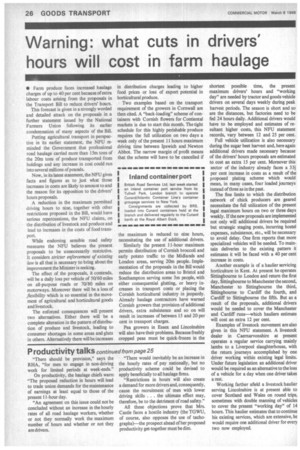Warning: what cuts in drivers' hours will cost in farm haulage
Page 28

If you've noticed an error in this article please click here to report it so we can fix it.
• Farm produce faces increased haulage charges of up to 40 per cent because of extra labour costs arising from the proposals in the Transport Bill to reduce drivers' hours.
This forecast is given in a strongly worded and detailed attack on the proposals in a further statement issued by the National Farmers Union following its earlier condemnation of many aspects of the Bill.
Putting agricultural transport in perspective in its earlier statement, the NFU reminded the Government that professional road haulage carried more than 15m tons of the 20m tons of produce transported from holdings and any increase in cost could run into several millions of pounds.
Now, in its latest statement, the NFU gives facts and figures as to just what those increases in costs are likely to amount to and the reason for its opposition to the drivers' hours proposals.
A reduction in the maximum permitted driving hours to nine, together with other restrictions proposed in the Bill, would have serious repercussions, the NFU claims, on the distribution of livestock and produce and lead to increases in the costs of food transport.
While endorsing sensible road safety measures the NFU believes the present proposals to be unnecessarily restrictive. It considers stricter enforcement of existing law is all that is necessary to bring about the improvement the Minister is seeking.
The effect of the proposals, it contends, will be a daily loss per vehicle of 50/60 miles on all-purpose roads or 70/80 miles on motorways. Moreover there will be a loss of flexibility which is so essential in the movement of agricultural and horticultural goods and livestock.
The enforced consequences will present two alternatives. Either there will be a complete alteration in the pattern of distribution of produce and livestock, leading to consumer shortages in some areas and gluts in others. Alternatively there will be increases in distribution charges leading to higher food prices or loss of export potential in horticultural produce.
Two examples based on the transport requirement of the growers in Cornwall are then cited. A "back-loading" scheme of containers with Cornish flowers for Contiental markets is due to start this month. The tight schedule for this highly perishable produce requires the full utilization on two days a week only of the present 11 hours maximum driving time between Ipswich and Newton Abbot. The narrow margin of profit means that the scheme will have to be cancelled if the maximum is reduced to nine hours, necessitating the use of additional drivers.
Similarly the present 11-hour maximum permits distribution of Cornish broccoli and early potato traffic to the Midlands and London areas, serving 20m people. Implementation of the proposals in the Bill would reduce the distribution areas to Bristol and Southampton serving some 3m people, with either consequential glutting, or heavy increases in transport costs or placing the Cornish horticultural industry in jeopardy. Already haulage contractors have warned Cornish growers that provision of additional drivers, extra subsistence and so on will result in increases of between 15 and 20 per cent in transport charges.
Pea growers in Essex and Lincolnshire will also have their problems. Because freshly cropped peas must be quick-frozen in the shortest possible time, the present maximum drivers' hours and "working day" are needed by tractor and goods vehicle drivers on several days weekly during peak harvest periods. The season is short and so are the distances, but factories need to be fed 24 hours daily. Additional drivers would have to be employed and estimates of resultant higher costs, this NFU statement records, vary between 12 and 25 per cent.
Full vehicle utilization is also necessary during the sugar beet harvest and, here again additional drivers made necessary because of the drivers' hours proposals are estimated to cost an extra 15 per cent. Moreover this sector of the industry already faces a 33+ per cent increase in costs as a result of the proposed plating scheme which would mean, in many cases, four loaded journeys instead of three as in the past.
The fine limits to which the distribution network of chick producers are geared necessitate the full utilization of the present legal maximum hours on two or three days weekly. If the new proposals are implemented not only will additional drivers be required but strategic staging posts, incurring hostel expenses, subsistence, etc., will be necessary to avoid delay. One firm reports that more specialized vehicles will be needed. To maintain deliveries to the existing pattern it estimates it will be faced with a 40 per cent increase in costs.
Another example is of a haulier servicing horticulture in Kent. At present he operates Sittingbourne to London and return the first day, Sittingbourne to Manchester the second, Manchester to Sittingbourne the third, Sittingbourne to Cardiff the fourth, and Cardiff to Sittingbourne the fifth. But as a result of the proposals, additional drivers would be needed to cover the Manchester and Cardiff runs—which hauliers estimate will cost an extra 12 per cent.
Examples of livestock movement are also given in this NFU statement, A livestock dealer in Caernarvonshire at present operates a regular service carrying mainly lambs to a Liverpool slaughterhouse, with the return journeys accomplished by one driver working within existing legal limits. Under future legislation an additional driver would be required as an alternative to the loss of a vehicle for a day when one driver takes a rest.
Working farther afield a livestock haulier serving Lincolnshire is at present able to cover Scotland and Wales on round trips, sometimes with double manning of vehicles to cover the present "working day" of 14 hours. This haulier estimates that to continue his existing services, which are extensive, he would require one additional driver for every two now employed.




































































































































